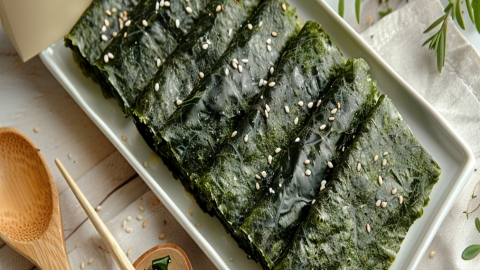What is the difference between seaweed and laver?
Generally speaking, seaweed sheets (nori) and laver are two related but distinct food ingredients, differing in scope, processing methods, appearance, taste, and nutritional content. When purchasing or consuming, one can distinguish between them based on their specific characteristics. A detailed analysis is as follows:
1. Origin
Laver refers to a general term for algae growing on shallow coastal rocks and includes multiple varieties such as Porphyra tenera (nori) and Porphyra euphlebia (Caihong laver). Seaweed sheets (nori), however, are products processed from certain varieties of laver and are considered processed products of laver rather than a distinct category of algae.
2. Processing Methods
Laver is usually either fresh or sun-dried simply into dried products, maintaining a relatively natural state. Seaweed sheets (nori) are processed from laver through multiple steps including cleaning, roasting, and seasoning. Some seaweed sheets may also include added seasonings such as salt, soy sauce, and sesame seeds.

3. Appearance
Dried laver is typically deep purple or dark brown in color, with a relatively thick texture and irregular shape, often appearing flaky or in chunks. Seaweed sheets (nori) are mostly bright green or dark green, thin and crisp in texture, with a neat and regular shape, usually in thin, even sheets with clean edges.
4. Taste and Texture
Dried laver has a coarser texture and a certain degree of fishy ocean odor. Its flavor is relatively mild when eaten directly and it is commonly used in soups or cold dishes. Seaweed sheets (nori) are crisp and delicious after seasoning, with a savory, salty flavor or other added flavors. They can be eaten directly as snacks or used to wrap rice or sushi.
5. Nutritional Content
Both laver and seaweed sheets (nori) have similar nutritional profiles, rich in protein, dietary fiber, iodine, and other nutrients. However, during processing, seaweed sheets may have added salt and sugar, resulting in a relatively higher sodium content. Laver, in contrast, retains more natural nutrients and has a lower sodium content.
In daily life, attention should be paid to checking product labels when purchasing, to distinguish between types and ingredients of laver and seaweed sheets. Although seaweed sheets are tasty, due to potentially high sodium levels, they should not be consumed in excess, especially for individuals needing to control sodium intake. Laver should be thoroughly washed before consumption to remove impurities and sand, ensuring food safety. Both should be stored in a dry and well-ventilated place to prevent moisture and spoilage.







